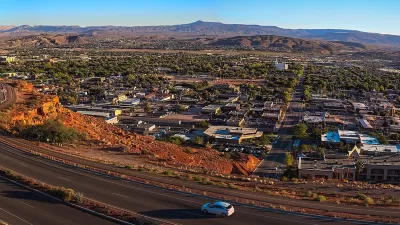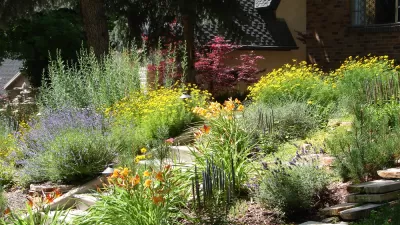The New Yorker traces the history of the American lawn from 1841, commenting on their unnatural origins, and finally analyzing the alternatives suggested by anti-lawn movements.
If one accepts the idea that lawns are, in a deep sense, unethical, how does one fill the front yard?
Over the years, many alternatives to the lawn have been proposed. Pollan, in his book "Second Nature" (1991), suggests replacing parts-or all-of the lawn with garden. In "Noah's Garden" (1993), Sara Stein, by contrast, advocates "ungardening"-essentially allowing the grass to revert to thicket. Sally and Andy Wasowski, in their "Requiem for a Lawnmower" (2004), recommend filling the yard with native trees and wildflowers. For those who don't want to give up the look or the playing space provided by a lawn, the Wasowskis suggest using Buffalo grass, one of the very few turf species native to North America. Smaller American Lawns Today, or SALT, is a concept developed by William Niering, who for many years was a professor of botany at Connecticut College. Niering planted trees around his property, then left most of the rest of his yard unmowed, to become a meadow. "The meadow can take as much of your remaining lawn as you want," he observes in an essay posted on SALT's Web site. "There are some people who prefer no lawn, which is ideal!" For the past few decades, David Benner, a horticulturist from Bucks County, Pennsylvania, has been touting moss as an alternative to grass: he himself has a one-acre "moss garden." Recently, there have been several calls to make the lawnspace productive. In "Food Not Lawns" (2006), Heather C. Flores argues that the average yard could yield several hundred pounds of fruits and vegetables per year. (If you live in an urban area and don't have a lawn, she suggests digging up your driveway.) "Edible Estates" (2008) is the chronicle of a project by Fritz Haeg, an architect and artist, who rips up conventional front yards in order to replace them with visually striking "edible plantings." Haeg calls his approach "full-frontal gardening."
FULL STORY: Turf War

Planetizen Federal Action Tracker
A weekly monitor of how Trump’s orders and actions are impacting planners and planning in America.

Maui's Vacation Rental Debate Turns Ugly
Verbal attacks, misinformation campaigns and fistfights plague a high-stakes debate to convert thousands of vacation rentals into long-term housing.

Restaurant Patios Were a Pandemic Win — Why Were They so Hard to Keep?
Social distancing requirements and changes in travel patterns prompted cities to pilot new uses for street and sidewalk space. Then it got complicated.

In California Battle of Housing vs. Environment, Housing Just Won
A new state law significantly limits the power of CEQA, an environmental review law that served as a powerful tool for blocking new development.

Boulder Eliminates Parking Minimums Citywide
Officials estimate the cost of building a single underground parking space at up to $100,000.

Orange County, Florida Adopts Largest US “Sprawl Repair” Code
The ‘Orange Code’ seeks to rectify decades of sprawl-inducing, car-oriented development.
Urban Design for Planners 1: Software Tools
This six-course series explores essential urban design concepts using open source software and equips planners with the tools they need to participate fully in the urban design process.
Planning for Universal Design
Learn the tools for implementing Universal Design in planning regulations.
Heyer Gruel & Associates PA
JM Goldson LLC
Custer County Colorado
City of Camden Redevelopment Agency
City of Astoria
Transportation Research & Education Center (TREC) at Portland State University
Jefferson Parish Government
Camden Redevelopment Agency
City of Claremont





























